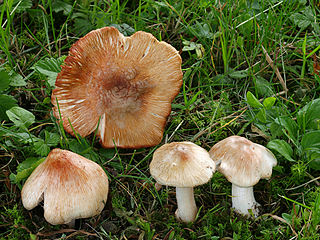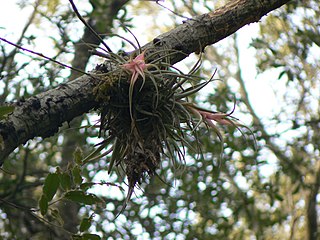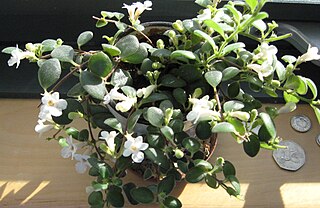
Inocybe erubescens, also known as I. patouillardii, commonly known as the deadly fibrecap, brick-red tear mushroom or red-staining Inocybe, is a poisonous basidiomycete fungus, one of many in the genus Inocybe and one of the few known to have caused death. It is found growing in small groups on leaf litters in association with beech. All mushroom guidebooks as well as mushroom hunters advise that the entire Inocybaceae should be avoided for consumption. The fruit bodies appear in spring and summer; the bell-shaped caps are generally pale pinkish in colour with red stains, with a reddish-pink stipe and gills.

Lophospermum is a genus of herbaceous perennial climbers or scramblers, native to mountainous regions of Mexico and Guatemala. Those that climb use twining leaf stalks. Their flowers are tubular, in shades of red, violet and purple, the larger flowers being pollinated by hummingbirds. Now placed in the greatly expanded family Plantaginaceae, the genus was traditionally placed in the Scrophulariaceae. The close relationship with some other genera, particularly Maurandya and Rhodochiton, has led to confusion over the names of some species.

The common wallaroo, also known as the euro, hill wallaroo, or simply wallaroo, is a species of macropod. The word euro is particularly applied to one subspecies.
Ornativalva is a genus of moths in the family Gelechiidae.

Tillandsia erubescens is a species of epiphytic plants of the genus Tillandsia. This species is endemic to Mexico, found over much of the country from Chihuahua to Oaxaca.

Codonanthe is a genus of mainly epiphytic plants in the family Gesneriaceae, endemic to the Atlantic Forest of Brazil. The botanical name comes from the Ancient Greek for 'bellflower'. They have white or pale pink flowers and somewhat fleshy leaves. In 2013, the genus was reduced in size when more than half of the species were transferred to Codonanthopsis. They can be grown as houseplants, particularly in hanging baskets. Artificial crosses with Nematanthus hybrids have produced the hybrid genus × Codonatanthus.

Olearia erubescens, commonly known as moth daisy-bush or pink-tip daisy-bush, is a species of flowering plant in the family Asteraceae. It is a shrub with stiff, prickly leaves and white "daisy" flowers, growing up to 2 metres high.

Lophospermum erubescens, known as Mexican twist or creeping gloxinia, is a climbing or sprawling herbaceous perennial plant, native to the Sierra Madre Oriental mountains of Mexico, where it is found along forest margins or canyon walls. It climbs by means of twining leaf stalks. Wild plants have pink and white tubular flowers, although other colours are found in cultivation. It has been cultivated as an ornamental plant since at least 1830. Although not frost-hardy, it will survive if its base and roots are protected from freezing in the winter. It has escaped from cultivation and become naturalized in tropical and subtropical areas of the world.

Lophospermum scandens is a scambling or climbing herbaceous perennial native to south central Mexico, with red-violet and white tubular flowers and toothed heart-shaped leaves. It grows at elevations between 1,400 and 2,400 m in dry habitats, including deciduous oak forests and recent lava flows. The long-tubed flowers are pollinated by hummingbirds. It has been used in gardens as an ornamental plant since the mid-19th century. Its roots require protection from frost in regions where this occurs in the winter. Hybrids of L. scandens are also grown.

Hygrophorus erubescens, commonly known as the blotched woodwax or pink waxcap, is an agaric fungus native to Scandinavia, Japan, Central Europe, Great Britain and North America.
An ant garden is a mutualistic interaction between certain species of arboreal ants and various epiphytic plants. It is a structure made in the tree canopy by the ants that is filled with debris and other organic matter in which epiphytes grow. The ants benefit from this arrangement by having a stable framework on which to build their nest while the plants benefit by obtaining nutrients from the soil and from the moisture retained there.

Codonanthopsis is a genus of flowering plants in the family Gesneriaceae. Its native range is from southern Mexico through tropical America to Bolivia and most of Brazil. Codonanthopsis species are generally trailing epiphytes with pale flowers. Most have a mutualistic relationship with tree-living ants: the plants provide the ants with food, including nectar, and give their nests structure and support, while the ants disperse the plants' seeds. The genus was considerably expanded in 2013 when species were transferred from Codonanthe. Some Codonanthopsis species are cultivated as houseplants, when they may be grown in hanging baskets.

Viburnum erubescens, the reddish viburnum, is a species of flowering plant in the family Viburnaceae. It is native to Sri Lanka, India, Nepal, Bangladesh, China, Myanmar, and Vietnam. It is a deciduous shrub that grows in forests and scrub. Flowers are fragrant and bloom April to June. The unimproved species is available from commercial suppliers, as is a putative variety, Viburnum erubescens var. gracilipes, the slender blushing viburnum, and a number of cultivars, including 'Foster', 'Lloyd Kenyon', 'Milke Danda', and 'Ward van Teylingen'.

Buellia erubescens, the common button lichen, is a species of lichen in the genus Buellia. It is found commonly on the bark and occasionally on the wood of Quercus, Pinus, Juniperus, or other species of trees with bark that has generally low pH. It is common between 600 and 3,000 m elevation, and is common in submontane to subalpine forests.

Codonanthopsis crassifolia is a species of plant in the family Gesneriaceae.
Codonanthopsis calcarata is a species of flowering plant in the family Gesneriaceae. This species is native to Bolivia, Brazil North, Brazil West-Central, Colombia, French Guiana, Guyana, Suriname, and Venezuela. Codonanthopsis calcarata is an epiphyte, and mainly grows in wet tropical biomes. Codonanthopsis calcarata was first published in 2013.
Codonanthopsis caribaea is a species of flowering plant in the family Gesneriaceae. This species is native to Guadeloupe to North Venezuela, and is a epiphyte and mainly grows in wet tropical biomes. Codonanthopsis caribaea, along with other species in its genus, was first published in 2013.
Codonanthopsis corniculata is a species of flowering plant in the family Gesneriaceae. This species is native to Peru and mainly grows in wet tropical biomes. Codonanthopsis corniculata, along with its other species in its genus, was first published in 2013.
Codonanthopsis luteola is a species of flowering plant in the family Gesneriaceae. This species is native to Panamá and mainly grows in wet subtropical biomes. Codonanthopsis luteola was first published in 2013.
Codonanthopsis macradenia is a species of flowering plant in the family Gesneriaceae. This species is native to Belize, Colombia, Costa Rica, Guatemala, Honduras, Mexico, and Panamá, and mainly grows in subtropical biomes. Codonanthopsis macradenia was first published in 2013.











